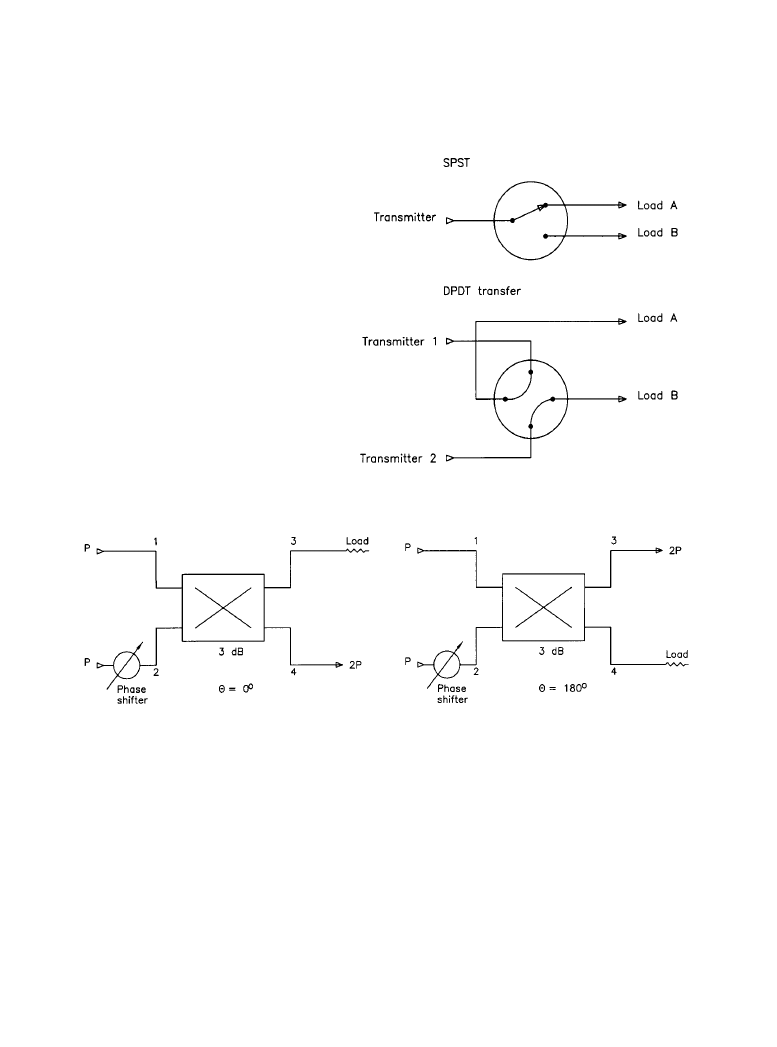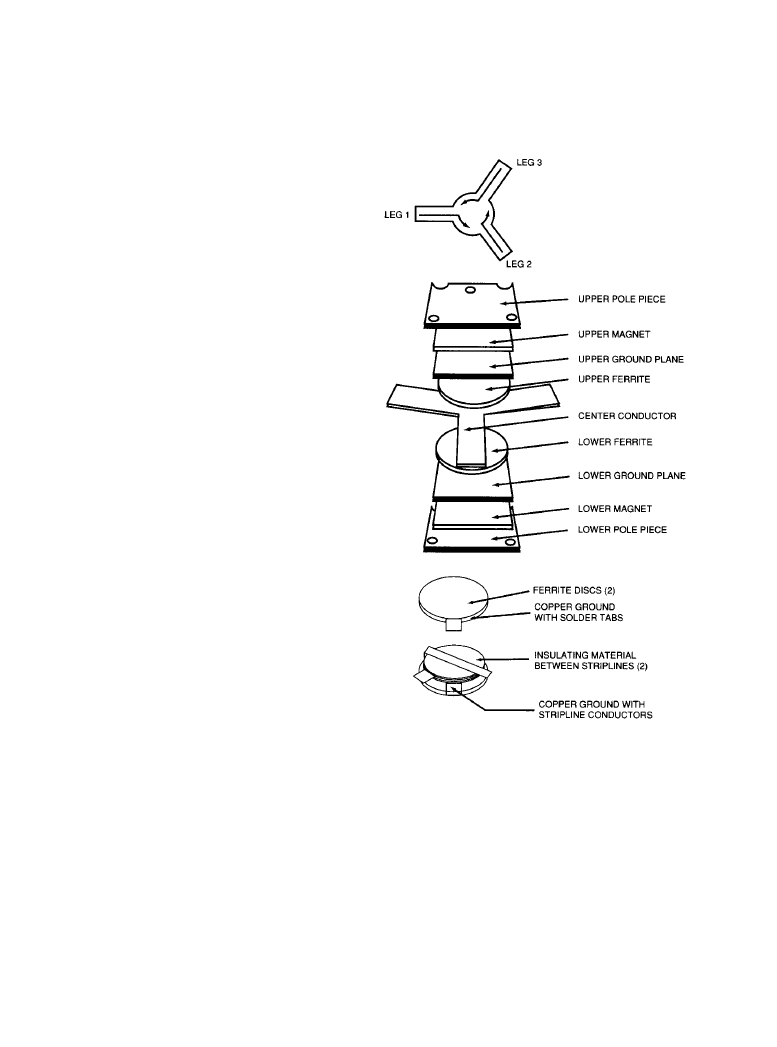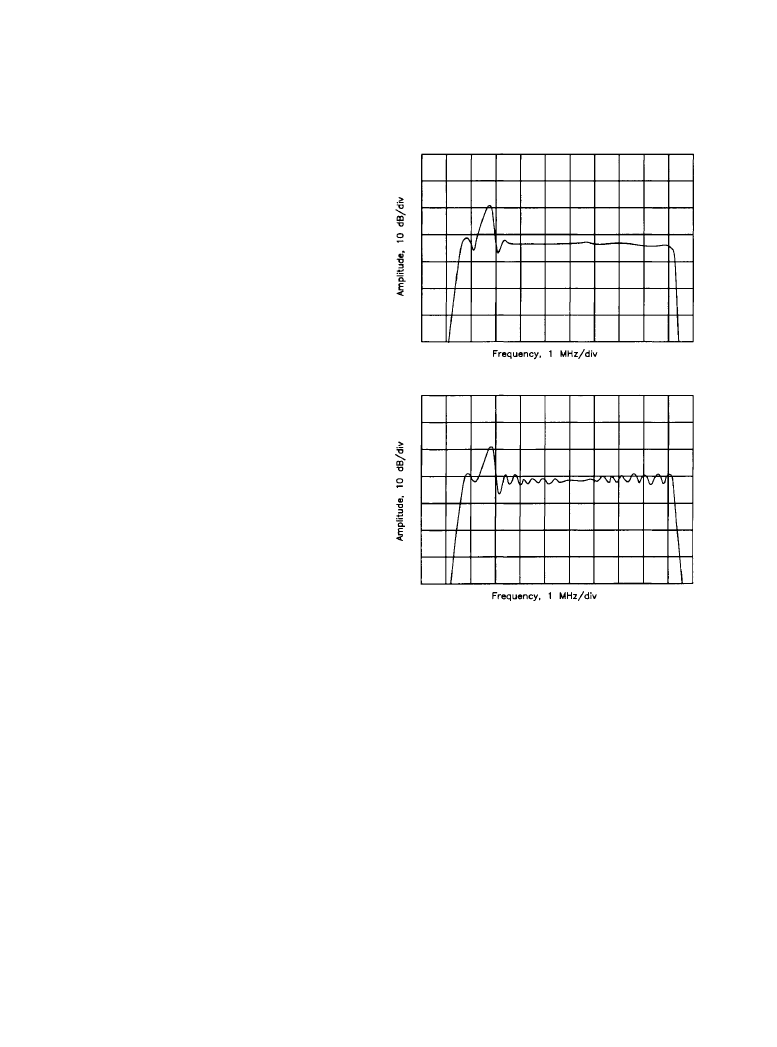ВУЗ: Казахская Национальная Академия Искусств им. Т. Жургенова
Категория: Книга
Дисциплина: Не указана
Добавлен: 03.02.2019
Просмотров: 21634
Скачиваний: 19

RF Combiner and Diplexer Systems 11-137
•
RF source 1 routed to output B
•
RF source 2 routed to output A
•
RF source 1 routed to output A
•
RF source 2 routed to output B
Figure 11.6.10
Common RF
switching configurations.
(
b)
Figure 11.6.11
Hybrid switching configurations: (
a) phase set so that the combined energy is
delivered to port 4, (
b) phase set so that the combined energy is delivered to port 3.
(
a)
Downloaded from Digital Engineering Library @ McGraw-Hill (www.digitalengineeringlibrary.com)
Copyright © 2004 The McGraw-Hill Companies. All rights reserved.
Any use is subject to the Terms of Use as given at the website.
RF Combiner and Diplexer Systems

11-138 Broadcast Transmission Systems
The key element in developing such a switch is a high-power phase shifter that does not
exhibit reflection characteristics. In this application, the phase shifter allows the line between the
hybrids to be electrically lengthened or shortened. The ability to adjust the relative phase
between the two input signals to the second hybrid provides the needed control to switch the
input signal between the two output ports.
If a continuous analog phase shifter is used, the transfer switch shown in Figure 11.6.12 also
can act as a hot switchless combiner where RF generators 1 and 2 can be combined and fed to
either output A or B. The switching or combining functions are accomplished by changing the
physical position of the phase shifter.
Note that it does not matter whether the phase shifter is in one or both legs of the system. It is
the phase difference (
θ1 – θ2) between the two input legs of the second hybrid that is important.
With 2-phase shifters, dual drives are required. However, the phase shifter needs only two posi-
tions. In a 1-phase shifter design, only a single drive is required, but the phase shifter must have
four fixed operating positions.
11.6.4 High-Power Isolators
The high-power ferrite isolator offers the ability to stabilize impedance, isolate the RF generator
from load discontinuities, eliminate reflections from the load, and absorb harmonic and inter-
modulation products. The isolator also can be used to switch between an antenna or load under
full power, or to combine two or more generators into a common load.
Isolators commonly are used in microwave transmitters at low power to protect the output
stage from reflections. Until recently, however, the insertion loss of the ferrite made use of isola-
tors impractical at high-power levels (25 kW and above). Ferrite isolators are now available that
can handle 500 kW or more of forward power with less than 0.1 dB of forward power loss.
Figure 11.6.12
Additional switching and combining functions enabled by adding a second hybrid
and another phase shifter to a hot switching combiner.
Downloaded from Digital Engineering Library @ McGraw-Hill (www.digitalengineeringlibrary.com)
Copyright © 2004 The McGraw-Hill Companies. All rights reserved.
Any use is subject to the Terms of Use as given at the website.
RF Combiner and Diplexer Systems

RF Combiner and Diplexer Systems 11-139
11.6.4a
Theory of Operation
High-power isolators are three-port versions of a family of devices known as circulators. The cir-
culator derives its name from the fact that a signal applied to one of the input ports can travel in
only one direction, as shown in Figure 11.6.13. The input port is isolated from the output port. A
signal entering port 1 appears only at port 2; it does not appear at port 3 unless reflected from
port 2. An important benefit of this one-way power transfer is that the input VSWR at port 1 is
dependent only on the VSWR of the load placed at port 3. In most applications, this load is a
resistive (dummy) load that presents a perfect load to the transmitter.
Figure 11.6.13
Basic characteris-
tics of a circulator: (
a) operational
schematic, (
b) distributed constant
circulator, (
c) lump constant circu-
lator. (
From [2]. Used with permis-
sion.)
(
a)
(
b)
(
c)
Downloaded from Digital Engineering Library @ McGraw-Hill (www.digitalengineeringlibrary.com)
Copyright © 2004 The McGraw-Hill Companies. All rights reserved.
Any use is subject to the Terms of Use as given at the website.
RF Combiner and Diplexer Systems

11-140 Broadcast Transmission Systems
The unidirectional property of the isolator results from magnetization of a ferrite alloy inside
the device. Through correct polarization of the magnetic field of the ferrite, RF energy will travel
through the element in only one direction (port 1 to 2, port 2 to 3, and port 3 to 1). Reversing the
polarity of the magnetic field makes it possible for RF flow in the opposite direction. Recent
developments in ferrite technology have resulted in high isolation with low insertion loss.
In the basic design, the ferrite is placed in the center of a Y-junction of three transmission
lines, either waveguide or coax. Sections of the material are bonded together to form a thin cylin-
der perpendicular to the electric field. Even though the insertion loss is low, the resulting power
dissipated in the cylinder can be as high as 2 percent of the forward power. Special provisions
must be made for heat removal. It is efficient heat-removal capability that makes high-power
operation possible.
The insertion loss of the ferrite must be kept low so that minimal heat is dissipated. Values of
ferrite loss on the order of 0.05 dB have been produced. This equates to an efficiency of 98.9
percent. Additional losses from the transmission line and matching structure contribute slightly
to loss. The overall loss is typically less than 0.1 dB, or 98 percent efficiency. The ferrite element
in a high-power system is usually water-cooled in a closed-loop path that uses an external radia-
tor.
The two basic circulator implementations are shown in Figures 11.6.13a and 11.6.13b. These
designs consist of Y-shaped conductors sandwiched between magnetized ferrite discs [2]. The
final shape, dimensions, and type of material varies according to frequency of operation, power
handling requirements, and the method of coupling. The distributed constant circulator is the
older design; it is a broad-band device, not quite as efficient in terms of insertion loss and leg-to-
leg isolation, and considerably more expensive to produce. It is useful, however, in applications
where broad-band isolation is required. More commonly today is the lump constant circulator, a
less expensive and more efficient, but narrow-band, design.
At least one filter is always installed directly after an isolator, because the ferrite material of
the isolator generates harmonic signals. If an ordinary band-pass or band-reject filter is not to be
used, a harmonic filter will be needed.
11.6.4b Applications
The high-power isolator permits a transmitter to operate with high performance and reliability
despite a load that is less than optimum. The problems presented by ice formations on a transmit-
ting antenna provide a convenient example. Ice buildup will detune an antenna, resulting in
reflections back to the transmitter and high VSWR. If the VSWR is severe enough, transmitter
power will have to be reduced to keep the system on the air. An isolator, however, permits contin-
ued operation with no degradation in signal quality. Power output is affected only to the extent of
the reflected energy, which is dissipated in the resistive load.
A high-power isolator also can be used to provide a stable impedance for devices that are sen-
sitive to load variations, such as klystrons. This allows the device to be tuned for optimum per-
formance regardless of the stability of the RF components located after the isolator. Figure
11.6.14 shows the output of a wideband (6 MHz) klystron operating into a resistive load, and into
an antenna system. The power loss is the result of an impedance difference. The periodicity of
the ripple shown in the trace is a function of the distance of the reflections from the source.
Downloaded from Digital Engineering Library @ McGraw-Hill (www.digitalengineeringlibrary.com)
Copyright © 2004 The McGraw-Hill Companies. All rights reserved.
Any use is subject to the Terms of Use as given at the website.
RF Combiner and Diplexer Systems

RF Combiner and Diplexer Systems 11-141
Hot Switch
The circulator can be made to perform a switching function if a short circuit is placed at the out-
put port. Under this condition, all input power will be reflected back into the third port. The use
of a high-power stub on port 2, therefore, permits redirecting the output of an RF generator to
port 3.
At odd 1/4-wave positions, the stub appears as a high impedance and has no effect on the out-
put port. At even 1/4-wave positions, the stub appears as a short circuit. Switching between the
antenna and a test load, for example, can be accomplished by moving the shorting element 1/4
wavelength.
Diplexer
An isolator can be configured to combine the aural and visual outputs of a TV transmitter into a
single output for the antenna. The approach is shown in Figure 11.6.15. A single notch cavity at
the aural frequency is placed on the visual transmitter output (circulator input), and the aural sig-
nal is added (as shown). The aural signal will be routed to the antenna in the same manner as it is
reflected (because of the hybrid action) in a conventional diplexer.
Figure 11.6.14
Output of a klystron
operating into different loads through
a high-power isolator: (
a) resistive
load, (
b) an antenna system.
(
b)
(
a)
Downloaded from Digital Engineering Library @ McGraw-Hill (www.digitalengineeringlibrary.com)
Copyright © 2004 The McGraw-Hill Companies. All rights reserved.
Any use is subject to the Terms of Use as given at the website.
RF Combiner and Diplexer Systems